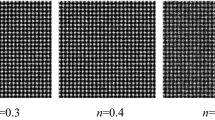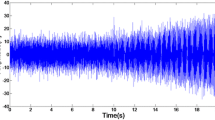Abstract
A typical symptom of vibration signals collected from rolling bearings with local faults is the existence of periodic transients, which makes the intrinsic structure of vibration signals become more and more regular. Generally, the vibration always contains multiple intrinsic oscillatory modes on different scales, which generally is caused by the interaction and coupling of machine components. Therefore, it is necessary to detect the behavior change of complexity of vibration signals in the view of multiple scales for fault information representation. The complexity and nonlinear failure symptom of rolling bearing can be evaluated by the recently proposed nonlinear dynamic tools, such as multiscale entropy (MSE) and its variants. Recently, the improved MSE method, multiscale dispersion entropy (MDE) and its improvement refined composite MDE (RCMDE) are developed to measure the complexity of time domain data. However, the intrinsic shortages of coarse graining approach that used in MDE and RCMDE have limited their application to fault feature representation. In this paper, an improved RCMDE approach named generalized refined composite multiscale fluctuation-based fractional dispersion entropy (GRCMFDE) is proposed to enhance MDE and RCMDE in complexity measurement of time series. GRCMFDE was compared with MPE, MDE, RCMDE by analyzing synthetic simulation signals to verify its advantages. After that, an intelligent fault diagnosis method was proposed by combining GRCMFDE with supervised multi-clustering feature selection and gray wolf optimized SVM for fault classification of rolling bearing. Lastly, the proposed fault diagnostic method was applied to two experimental data set analysis by comparing with multiscale permutation entropy, MDE- and RCMDE-based fault diagnostic methods and the comparison results indicate that the proposed method can effectively diagnose the fault locations and severities of rolling bearing and get a higher fault identifying rate than the comparative methods.




















Similar content being viewed by others
References
Xu, X., Qiao, Z., Lei, Y.: Repetitive transient extraction for machinery fault diagnosis using multiscale fractional order entropy infogram. Mech. Syst. Signal Process. 103, 312–326 (2018)
Zheng, J., Pan, H., Cheng, J.: Rolling bearing fault detection and diagnosis based on composite multiscale fuzzy entropy and ensemble support vector machines. Mech. Syst. Signal Process. 85, 746–759 (2017)
Yin, Y., Shang, P.: Multivariate weighted multiscale permutation entropy for complex time series. Nonlinear Dyn. 88(3), 1707–1722 (2017)
Yin, Y., Shang, P.: Multivariate multiscale sample entropy of traffic time series. Nonlinear Dyn. 86(1), 479–488 (2016)
Li, Y., Xu, M., Wang, R., et al.: A fault diagnosis scheme for rolling bearing based on local mean decomposition and improved multiscale fuzzy entropy. J. Sound Vib. 360, 277–299 (2016)
Zhang, L., Xiong, G., Liu, H., et al.: Bearing fault diagnosis using multi-scale entropy and adaptive neuro-fuzzy inference. Expert Syst. Appl. 37(8), 6077–6085 (2010)
Zheng, J., Cheng, J., Yu, Y., et al.: A rolling bearing fault diagnosis method based on multi-scale fuzzy entropy and variable predictive model-based class discrimination. Mech. Mach. Theory 78(16), 187–200 (2014)
Zheng, J., Tu, D., Pan, H., et al.: A refined composite multivariate multiscale fuzzy entropy and Laplacian score-based fault diagnosis method for rolling bearings. Entropy 19(11), 585 (2017)
Li, Y., Xu, M., Wei, Y., et al.: A new rolling bearing fault diagnosis method based on multiscale permutation entropy and improved support vector machine based binary tree. Measurement 77, 80–94 (2016)
Zheng, J., Pan, H., Yang, S., et al.: Generalized composite multiscale permutation entropy and Laplacian score based rolling bearing fault diagnosis. Mech. Syst. Signal Process. 99, 229–243 (2018)
Heurtier, H.: The multiscale entropy algorithm and its variants: a review. Entropy 17, 3110–3123 (2015)
Rostaghi, M., Azami, H.: Dispersion entropy: a measure for time-series analysis. IEEE Signal Process. Lett. 23(5), 610–614 (2016)
Azami, H., Rostaghi, M., Abasolo, D., et al.: Refined composite multiscale dispersion entropy and its application to biomedical signals. IEEE Trans. Biomed. Eng. 64(12), 2872–2879 (2017)
Azami, Hamed, Arnold, Steven E., Sanei, Saeid, et al.: Multiscale fluctuation-based dispersion entropy and its applications to neurological diseases. IEEE Access 7, 68718–68733 (2019)
He, S., Sun, K., Wang, R.: Fractional fuzzy entropy algorithm and the complexity analysis for nonlinear time series. Eur. Phys. J. Special Top. 227(7–9), 943–957 (2018)
Karci, A.: Fractional order entropy: new perspectives. Opt. Int. J. Light Electron Opt. 127(20), 9172–9177 (2016)
Wahyu, C., Tegoeh, T.: A review of feature extraction methods in vibration-based condition monitoring and its application for degradation trend estimation of low-speed slew bearing. Machines 5(4), 21 (2017)
Deng, C., Zhang, C., He, X.: Unsupervised feature selection for multi-cluster data. In: ACM SIGKDD International Conference on Knowledge Discovery and Data Mining (2010)
Liu, Z., Cao, H., Chen, X., et al.: Multi-fault classification based on wavelet SVM with GWO algorithm to analyze vibration signals from rolling element bearings. Neurocomputing 99(1), 399–410 (2013)
Rezaei, H., Bozorghaddad, O., Chu, X.: Grey wolf optimization (GWO) algorithm. In: Advanced Optimization by Nature-Inspired Algorithms (2018)
Costa, M.D., Goldberger, A.L.: Generalized multiscale entropy analysis: application to quantifying the complex volatility of human heartbeat time series. Entropy 17(3), 1197–1203 (2015)
Machado, J.T.: Fractional order generalized information. Entropy 16(4), 2350–2361 (2014)
http://csegroups.case.edu/bearingdatacenter/pages/download-data-file. Bearing Data Center, Case Western Reserve University
Smith, W.A., Randall, R.B.: Rolling element bearing diagnostics using the Case Western Reserve University data: a benchmark study. Mech. Syst. Signal Process. 64–65, 100–131 (2015)
Zheng, J., Cheng, J., Yu, Y.: Generalized empirical mode decomposition and its applications to rolling element bearing fault diagnosis. Mech. Syst. Signal Process. 40(1), 136–153 (2013)
Zheng, J., Dong, Z., Pan, H., et al.: Composite multi-scale weighted permutation entropy and extreme learning machine based intelligent fault diagnosis for rolling bearing. Measurement 143, 69–80 (2019)
Acknowledgements
This work was supported by the National Natural Science Foundation of China (No. 51975004), the National Key Technologies Research & Development Program of China (No. 2017YFC0805100), the Natural Science Foundation of Anhui Provence, China (No. 2008085QE215) and the Key Program of Natural Science Research of Higher Education in Anhui Province of China (No. KJ2019A053, KJ2019A092).
Author information
Authors and Affiliations
Corresponding author
Ethics declarations
Conflict of interest
The authors declare that they have no conflict of interest.
Additional information
Publisher's Note
Springer Nature remains neutral with regard to jurisdictional claims in published maps and institutional affiliations.
Appendix A: Reviews of DE and MDE
Appendix A: Reviews of DE and MDE
For a given univariate time series \( X = \left\{ {x_{1} ,x_{2} , \ldots ,x_{N} } \right\} \) with a length of N, the computation steps of DE are given as follows [12, 13].
-
(1)
The original time series \( X \) is mapped to \( Y = \left\{ {y_{1} ,y_{2} , \ldots ,y_{N} } \right\} \) by using normal cumulative distribution function (NCDF) shown as
$$ y_{j} = \frac{1}{{\sigma \sqrt {2\pi } }}\int\limits_{ - \infty }^{{x_{j} }} {e^{{\frac{{ - \left( {t - \mu } \right)^{2} }}{{2\sigma^{2} }}}} } {\text{d}}t. $$(4)It is obvious that \( y_{i} \in (0,1) \). \( \sigma \) is standard deviation and \( \mu \) is mean of \( X \).
-
(2)
By using the linear transform shown in Eq. (2), all elements of \( Y \)(\( y_{i} \), \( j = 1,2, \ldots ,N \)) are mapped to c classes (which is an integer), i.e.,
$$ z_{j}^{c} = R\left( {c \cdot y_{j} + 0.5} \right) $$(5)where R represents the rounding operation and \( z_{j}^{c} \) represents the jth member of the classified time series. Although the step (2) is linear, the whole mapping way is nonlinear for the use of NCDF in step (1).
-
(3)
For the given time delay d and embedding dimension m, \( {\text{z}}_{i}^{m,c} \) can be obtained according to \( z_{i}^{m,c} = \left\{ {z_{i}^{c} ,z_{i + d}^{c} , \ldots ,z_{i + (m - 1)d}^{c} } \right\} \), \( i = 1,2, \ldots ,N - (m - 1)d \). Each time series \( {\text{z}}_{i}^{m,c} \) can be mapped to a dispersion pattern \( \pi_{{v_{0} v_{1} \ldots v_{m - 1} }} \), where \( z_{i}^{c} = v_{0} \), \( z_{i + d}^{c} = v_{1} \),…, \( z_{i + (m - 1)d}^{c} = v_{m - 1} \). The signal has m members, and they all belong to the integer interval from 1 to c. The number of possible dispersion patterns is equal to \( c^{m} \).
-
(4)
The relative frequency for each dispersion patterns \( \pi_{{v_{0} v_{1} \ldots v_{m - 1} }} \) can be estimated by
$$ p\left( {\pi_{{v_{0} v_{1} \ldots v_{m - 1} }} } \right) = \frac{{{\text{Number}}\left\{ {i\left| {i \le N - (m - 1)d,\;z_{i}^{m,c} \;{\text{has}}\;{\text{type}}\;\pi_{{v_{0} v_{1} \ldots v_{m - 1} }} } \right.} \right\}}}{N - (m - 1)d} $$(6)where \( p\left( {\pi_{{v_{0} v_{1} \ldots v_{m - 1} }} } \right) \) stands for the number of dispersion patterns of \( \pi_{{v_{0} v_{1} \ldots v_{m - 1} }} \) assigned to \( {\text{z}}_{i}^{m,c} \) divided by the total number of embedded signals for embedding dimension m.
-
(5)
The DE of \( X \) is computed by
$$ {\text{DisEn}}(X,m,c,d) = - \sum\limits_{\pi = 1}^{{c^{m} }} {p\left( {\pi_{{v_{0} v_{1} \ldots v_{m - 1} }} } \right)\ln \left( {p\left( {\pi_{{v_{0} v_{1} \ldots v_{m - 1} }} } \right)} \right)} $$(7)
It can be found from the algorithm of DE that when all probability of distribution patterns \( p\left( {\pi_{{v_{0} v_{1} \ldots v_{m - 1} }} } \right) \) are equal, DE gets the largest entropy value \( \ln (c^{m} ) \) and a typical example is Gaussian white noise. In contrast, when the probability of distribution pattern \( p\left( {\pi_{{v_{0} v_{1} \ldots v_{m - 1} }} } \right) \) is unitary, i.e., only one value is not equal to zero, DE get the smallest value, which indicates that the time series is a completely predictable data and a typical example is the periodic signal with low frequency.
Based on DE, the computation steps of MDE are given as follows.
-
(1)
For a given univariate data \( W = \left\{ {w_{1} ,w_{2} , \ldots ,w_{L} } \right\} \) with a length of L, firstly, it is divided into \( \tau \) non-overlapping segments with length \( \left\lfloor {{L \mathord{\left/ {\vphantom {L \tau }} \right. \kern-0pt} \tau }} \right\rfloor \). Then, the average of each segment is computed to derive the coarse-grained time series. This process is named coarse graining and is given as follows:
$$ y_{j}^{(\tau )} = \frac{1}{\tau }\sum\limits_{a = (j - 1)\tau + 1}^{j\tau } {w_{a} } ,\quad 1 \le j \le \left\lfloor {{L \mathord{\left/ {\vphantom {L \tau }} \right. \kern-0pt} \tau }} \right\rfloor $$(8)\( \tau \) is called scale factor. \( y_{{}}^{(1)} \) is the original data \( W \) and when \( \tau > 1 \), \( W \) is divided into \( \tau \) coarse-grained time series \( y^{(\tau )} \) with a length of \( \left\lfloor {{N \mathord{\left/ {\vphantom {N \tau }} \right. \kern-0pt} \tau }} \right\rfloor \) (which stands for the largest integral smaller than \( \{ x(i),i = 1,2, \cdots ,N\} \)).
-
(2)
The DE of \( y^{(\tau )} \) is estimated by
$$ {\text{MDE}}(W,\tau ,m,c,d) = {\text{DE}}\left( {y^{(\tau )} ,m,c,d} \right) $$(9)
The DEs over different time scales are depicted as a function of scale factor, and this process is called MDE analysis.
Rights and permissions
About this article
Cite this article
Zheng, J., Pan, H. Use of generalized refined composite multiscale fractional dispersion entropy to diagnose the faults of rolling bearing. Nonlinear Dyn 101, 1417–1440 (2020). https://doi.org/10.1007/s11071-020-05821-1
Received:
Accepted:
Published:
Issue Date:
DOI: https://doi.org/10.1007/s11071-020-05821-1




